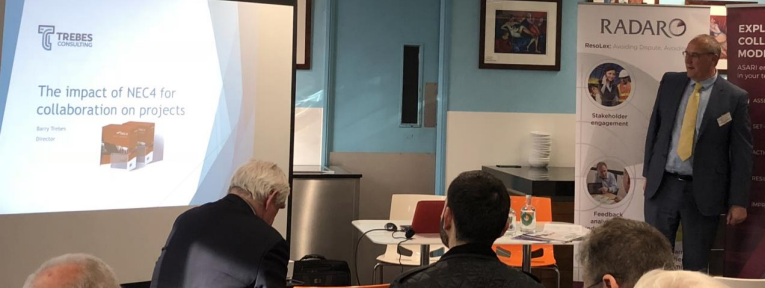Barry TrebesFRICS, FAPM, FInstCES
Barry is a Chartered Surveyor, initiator of the first web-based NEC management system in 1990. He co-authored NEC Manuals; “Managing Reality”, NEC3 Role of the Supervisor and NEC3 Role of Project Manager and the BSi published document, Project Management in the construction industry.
This month’s round table was designed to encourage an exploration of the use of the NEC4 contract as a tool for collaboration. Any summary of any discussion on construction contracts is fraught with danger in that the commentator can either over-elaborate or alternatively completely miss a critical point. We offer the following as an attempt to find the right balance of the evening’s discourse.
The aim of the NEC suite is that of taking a contract off the shelf and add the detail. Within the off the shelf contract, the promotion of collaborative behaviour is a given. The overriding message from NEC4 is that contracts work when people understand the risk within the contract. Drafted for use anytime and anywhere with a mix of options designed to be project-specific NEC4 is evolution not revolution. The overriding principle is one of agreeing change as the project proceeds to a timescale to give certainty of outcome. The contract form is demanding in terms of “doing things”, particularly in the following areas:
• Better management practice
• Good risk management processes
• Collaboration
• Alliancing
• Good communications
• Change management
Of key importance are the ‘early warnings’ for risk management and change management with a contract expectation that to get the best out of its use there will be an investment in supporting resources both in terms of people and systems. Early warnings are important in focussing on communications so that early warnings are “scouting ahead looking for risks”. The expectation is that the early warnings register will interface as an EWS tool for the early warning of risks to be fed into the risk register. The prevailing ethos of NEC4 is one of looking ahead and forecasting rather than forensic analysis. This is relevant in the areas of BIM and ECI with options reflecting specific project circumstances.
The overriding operating principle of the use of Z clauses is “What is the mischief you are trying to deal with?” There is an attempt to pre-empt the misuse of Z clauses where project specific “boilerplate” drafting attempts to change the contract into something it is not.
There is a refinement of processes with the intention of interfacing with project management systems particularly around early warnings systems (EWS), programming, contractor’s proposals, and proposed instructions.
Encouraging collaborative behaviour
NEC4 Alliance Contract, intended to unite teams, launches at the NEC Conference on 20th June. Again, the key question is “Can any contract force you to collaborate?” While the contract is important, collaboration comes back to better management.
There are also improvements around the status and use of contractor’s proposals and throughout the contract clarifications and simplifications around the schedule of cost components.
NEC4 also introduces the consequence of inaction through sanctions, be they from the project manager or the contractor. Changing circumstances need supporting by risk EWS, programme forecasting and continuous final assessments.
Risk allocation is vitally important in drafting contracts. There needs to be a better fundamental alignment of risk allocation under all contract forms. In putting together and delivering contracts use of better risk identification is needed with more open allocation of risk between client risk and contractor risk. In NEC4 project specific attention needs to focus around clauses 80.1 client liabilities and 81.1 contractor liabilities. Early warnings should find opportunities to mitigate risk, particularly relating to supporting BIM, dispute negotiation and dispute avoidance which all impact on financial agreement.
There is a view in some quarters that without the right working processes and systems, too much collaboration activity exhausts employees and saps cooperation. Questions are now asked around whether there is collaboration overload. The distribution of collaborative work is often lopsided. Effective collaboration needs rewarding. One solution is to develop a series of KPIs that will stimulate collaborative behaviours on a group basis.
So, whilst NEC is good on processes, there is a question as to whether any form of contract can shape human behaviour other than to put constraints that lead to transactional project culture. Questions posed in the room included:
•How this might change?
•What is there that is complimentary to risk and collaboration?
•What is the wisdom to get collaboration to work?
The emerging theme was that investment is key both in terms of resources in the form of systems to support the contract and coaching and mentoring to encourage parties to work together. Collaborative intelligence presupposes a willingness to collaborate and share and knowing how to share. This means understanding team dynamics and using the right tools and the right technology to support aspirations. This in turn means proper communication and using the right supporting processes.
People tend to use the contract form they know. Organisations have invested a great deal in their preferred contract forms and this gives familiarity. NEC4 is gaining influence and take up. However the move from NEC3
will take time because of the previous worthwhile investment in the NEC3 form. There are no concerns as to take up and it is envisaged over time that evolution will move from NEC4 to NEC5. Ultimately theclient decides on the form of contract. Any effective collaborative contract needs an investment in people and systems to support its use.
The bottom line was that irrespective of the form of contract chosen, sharing information and communicating give better outcomes.
Tony Llewellyn, April 2018
